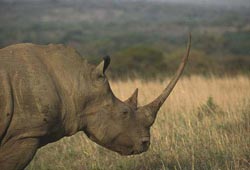Poaching threatens savannah ecosystems

Rhino<br>Swedish University of Agricultural Sciences <br>
The white rhino (Ceratotherium simum), and other megaherbivores, are key drivers of ecosystem functioning because they´re not controlled by predation.
A new study by Joris Cromsigt and Mariska te Beest, published in Journal of Ecology, highlights the role of the white rhino in the savannah ecosystems.
Earlier empirical studies on the ecosystem impact of megaherbivores are strongly biased to African elephant with very little contemporary evidence for other megaherbivore species. Cromsigt and te Beest quantifies how rhino recolonized Kruger National Park (KNP) following their re-introduction in the 1960s to create a unique ‘recolonization experiment’ and tests how this megagrazer is affecting the structure of savanna grasslands.
The researchers identified landscapes that rhino recolonized long time ago versus landscapes that were recolonized more recently. The assumption was that time since colonization represents a proxy for extent of rhino impact. Grassland heterogeneity on 40 transects covering a total of 30 kilometer were recorded. Short grass cover was clearly higher in the high rhino impact than low rhino impact landscape. Moreover, they encountered about 20 times more grazing lawns, a specific grassland community, in the high rhino impact landscape.
The conclusion is that white rhinoceros may have started to change the structure and composition of KNP’s savanna grasslands. The amount of short grass in savannas has important consequences for other species, but also components of ecosystem functioning such as fire regimes. The results highlight that this poaching crisis not only affects the species but threatens the potentially key role of this megaherbivore as a driver of savannah functioning.
Restoration of a megaherbivore: landscape-level impacts of white rhinoceros in Kruger National Park, South Africa
The article is published online in Journal of Ecology 12 feb 2014,
DOI: 10.1111/1365-2745.12218 http://onlinelibrary.wiley.com/doi/10.1111/1365-2745.12218/abstract
Contact information: Assistant Professor Joris Cromsigt, Swedish University of Agricultural Sciences, Department of Wildlife, Fish and Environmental Studies, joris.cromsigt@slu.se
+27 727547596
Pressofficer: Olof Bergvall, +46 90-786 82 11, olof.bergvall@slu.se
Weitere Informationen:
http://www.slu.se/en/departments/wildlife-fish-environmental-studies/staff/list/cromsigt-joris/
Joris Cromsigt personal webpage
Media Contact
More Information:
http://www.vr.seAll latest news from the category: Ecology, The Environment and Conservation
This complex theme deals primarily with interactions between organisms and the environmental factors that impact them, but to a greater extent between individual inanimate environmental factors.
innovations-report offers informative reports and articles on topics such as climate protection, landscape conservation, ecological systems, wildlife and nature parks and ecosystem efficiency and balance.
Newest articles

High-energy-density aqueous battery based on halogen multi-electron transfer
Traditional non-aqueous lithium-ion batteries have a high energy density, but their safety is compromised due to the flammable organic electrolytes they utilize. Aqueous batteries use water as the solvent for…

First-ever combined heart pump and pig kidney transplant
…gives new hope to patient with terminal illness. Surgeons at NYU Langone Health performed the first-ever combined mechanical heart pump and gene-edited pig kidney transplant surgery in a 54-year-old woman…

Biophysics: Testing how well biomarkers work
LMU researchers have developed a method to determine how reliably target proteins can be labeled using super-resolution fluorescence microscopy. Modern microscopy techniques make it possible to examine the inner workings…





















